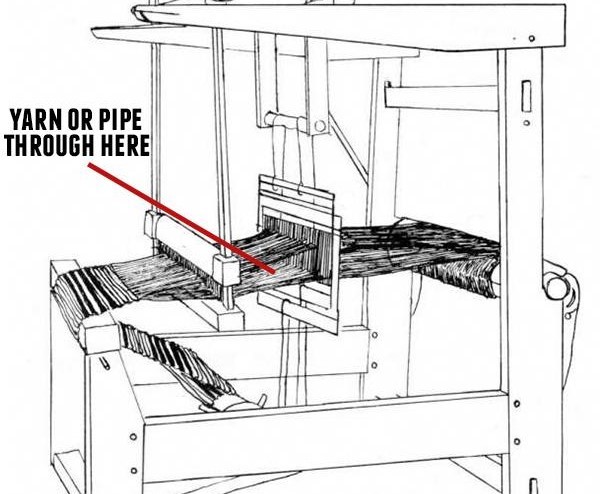Handmade rugs come in a range of different types and styles. From handwoven rugs, to hand-tufted, hand-knotted, hand-hooked, and flatweave carpets, the mesmerizing rug world has a lot to offer.
The construction of a handmade rug determines its texture, strength, and longevity. For example, Ziegler rugs, Pakistani rugs, and other such Oriental carpets with a high knot density tend to live much longer than flatweave and machine-made rugs.

Types of Handmade Rugs
Handmade rugs, like many other pieces of art, require a lot of effort, time and expert skills to be made. But not all handmade rugs are made the same way, and a rug’s construction defines its value.
Before we get into the types of rugs and their construction, here is a glossary of terms that you need to know:
- Weft: This is the building block of any handmade rug’s structure. It’s the horizontal yarn that’s passed through the rug.
- Warp: This part makes up the foundation of the rug. It’s the vertical yarn, usually cotton, that’s attached to the upper and bottom beam.
- Pile: The fibers of wool, cotton or silk attached to the rug’s foundation to create a thickness that extends from the base of rug.

Even in the handmade rugs crafted for the Western market, such as modern Ziegler rugs, these basic components are the same as ancient rugs. The only major construction factor that changes from one rug to another is the weaving technique.
Hand-Knotted Rugs
These are the traditional Persian rugs that are still crafted in many countries, included Iran, Afghanistan, and Pakistan. The major exporter of hand-knotted rugs is Pakistan and the carpets are known for their velvety texture and durability.
How are hand-knotted rugs made?
As the name defines, to make a hand-knotted rug, knots are created by weavers in a symmetrical manner to craft a pile.
Here are the steps followed during the making process of a hand-knotted rug:
- The process starts by passing the yarn or wool fiber through one vertical warp on the left.
- The yarn is passed to the front and brought to the right side of the warp.
- Then the yarn is passed through the right side of the next warp.
- Lastly, the yarn id brought back to the front on the left side of the warp.
These four steps help create a knot, like this:

A single area rug of the size 8x10 feet can have anywhere between one to six million knots per square inch! And such hand-knotted rugs are made in a long time period of 12-14 months.
Moreover, if you want to buy a handmade rug, such as a modern Ziegler rug, and are looking for something durable, ask the rug dealer about the rug’s knot density. The higher the KPSI count (knots per square inch), the more durable your rug would be!
Flat-Weave and Hand-Loomed Rugs
Flat-weave rugs are woven on a loom and the process is comparatively less laborious than hand-knotted rugs. Flatweave rugs don’t have a pile and these carpets are created by throwing the weft through the middle of the top and bottom warp. Then the weft and warp are both interwoven while the weaver compacts the rug with beater.
Flatweave rugs are reversible and the perfect option for outdoor areas where you want something light and less expensive.

Unlike flatweave rugs, loomed rugs have a pile but the process is quite similar. The only difference is that a rod pipe is passed through the top and bottom warp instead of weft. This helps lift the yarn and then a pile is formed. Throughout the making of loomed rugs, the weavers employ both techniques interchangeably (passing weft through warp and rod pipe). Lastly, the loops formed by the rod pipe are either left uncut for a fuller texture, or they’re cut by the weaver.
Hand-Tufted Rugs
Tufted rugs are made in a manner that is somewhat similar to loomed rugs. However, instead of starting with just warp and weft, a foundation cloth is used for the making of tufted rugs. This foundation cloth is a pre-woven piece of fabric with small squares.
Have a look at this image below for better understanding:

The process begins with hanging the foundation cloth and stretching it tight. Then the weavers use a tufting gun similar to the one shown in the image above to create a pattern. The yarn or wool fibers are shot through the back of the rug to the front using a tufting gun. Then this yarn is cut to form the rug pile.
Hand Hooked Rugs
Similar to the hand tufted rugs, the hand-hooked rugs are also made on a pre-woven foundation cloth. The difference is that instead of using a tufting gun, a hooking tool is used by the weavers to pass the yarn through the rug’s foundation.
Also, unlike pushing the yarn from the back to front as done in hand-tufted rugs, the yarn is hooked from the front of the foundation to the back, and then brought to the front again.
Which rug type from the ones mentioned above is the most durable?
The hand-knotted ones!
Hand-knotted rugs, such as Ziegler rugs, Bokhara rugs, Oushak rugs, and numerous other Persian rugs are made over a long time period, using the best quality of wool and made by expert weavers. The rugs are highly durable and can last long enough to become a family heirloom!













